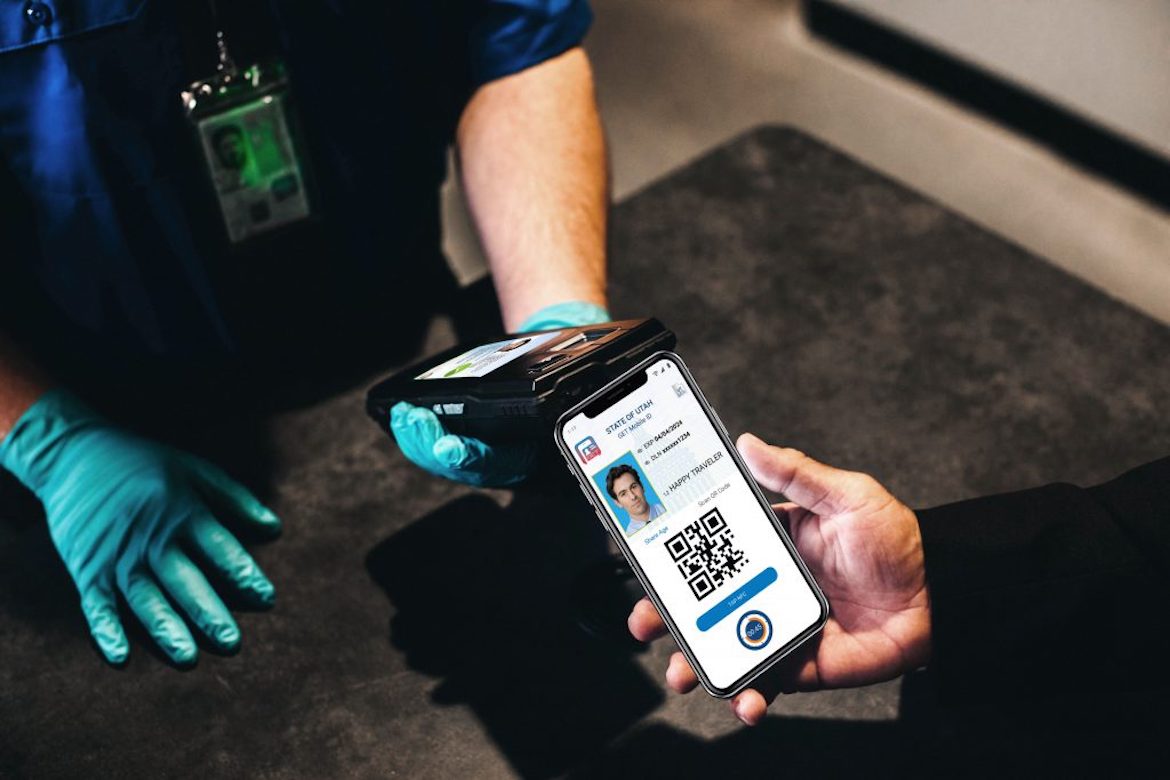8 minutes
Utah Community CU helps state test a secure, convenient system for members to verify their identity for face-to-face transactions.
Imagine you’re hitting the road to your credit union and a store or three, and in your pocket is just a set of keys and your smartphone. No wallet. No problem.
It might not be too long before you can store not only your cards and digital payment credentials but also your driver’s license in your mobile wallet.
Some members of Utah Community Credit Union have already been doing this since June 2021, when the CU joined the state’s pilot of digital driver’s licenses.
“The feedback we’ve heard from early adopters is that they love that now they don’t have to have two things in their pockets. They just have their phone,” says Justin Olson, CIO of the $2.4 billion credit union in Orem, Utah. He says the driver’s license app pairs well with the CU’s mobile app, so if the test expands into statewide use, many more point-of-sale transactions can be completely digital. Consumers would be able to tap-and-pay with their mobile wallet, and if they need to provide state-approved ID, they’ll have an app for that, too.
Rolling Out the Utah Digital Driver’s License
The pilot program allows participating residents of Utah to use their digital driver’s licenses in state liquor stores, Harmon’s grocery stores and at Utah Community CU. The state was looking for stakeholder businesses that depend on government-issued identification to support their businesses. The credit union previously has done a few technology projects with the state of Utah, including a collaboration to automate the process of securing lien on a vehicle title. So, the state asked the CU to be the financial services provider for the mobile driver’s license pilot.
The vision is for Utah residents to be able to use the digital driver’s licenses seamlessly at many places, including airports, financial institutions, stores and car rental agencies.
For about 18 months before the launch of the pilot, Utah Community CU sat in on discussions about how the state’s digital driver’s license technology might work.
Once the pilot launched, the CU hosted two education and enrollment events about digital driver’s licenses for members and the general public. State officials attended with tablets they used to scan physical driver’s licenses and provision mobile driver’s licenses.
“We saw hundreds and hundreds of people come on those two days and enroll, and most of them were our members,” Olson says. “I thought it was a great partnership with the state.”
How the Utah Digital Driver’s License Works
Right now mobile driver’s licenses use QR code technology via the GET Mobile ID app from Get Group North America. As with electronic phone payments, pilot participants also can prove their identity with a tap of their phone on a near-field communications reader. The vision is for the system to work using Bluetooth technology as well.
After the state provisions a digital driver’s license with security and controls designed to protect personal data, a user initially sets a personal identification number and later can change to another authentication method, such as facial recognition. Importantly, the app gives consumers control over which information from their driver’s license they want to disclose for any given transaction, Olson says.
Consider this example. A bouncer at a club asks for ID. A Utah resident with a digital driver’s license can choose which pieces of information to disclose. The resident might open the app, choose “verify age” and hit “submit.” The app will then generate a QR code (which is only good for 60 seconds). The person who wants to enter the club points their phone toward the bouncer who scans it with their device, connecting it to the state’s system, which responds with the person’s photo and an “over 21” confirmation. The bouncer doesn’t have access to that person’s age—or even their birthday—nor to their address, phone number, height or weight. But the bouncer has confirmation that this person is old enough to enter the club.
Similarly, if members who are enrolled in the program come into one of Utah Community CU’s participating branches, they can use their smartphone to share only the info the CU requires. Through QR code scan, the CU’s tech reaches out to the state’s system and gets back the photo of the person connected with this ID plus the data the member (or prospective member) has chosen to share.
“What we get out of that is actually pretty significant: a verification against the state’s data—in real time—that this is a valid identity, and we can see the photo that the state says belongs to that ID,” Olson explains. “That’s a pretty powerful way to verify, at the point of transaction, that this isn’t a fake or stolen identity.”
In addition, the pilot digital driver’s license process seems less clunky for remote transactions than the required verification process for using a physical ID. For the credit union to verify an identity using a physical card, a member must do these sorts of things: take a photo of the front and back of their physical driver’s license, answer out-of-wallet questions, such as, “Which of the following phone numbers are you associated with?”; and take and upload a selfie.
Another advantage of digital driver’s licenses is that at the beginning of a transaction such as an account opening, applicants get the option to have the mobile ID data populate the application.
“They don’t have to manually key in their address, birthdate and other data the CU is required to collect,” Olson explains. “It can really speed things up—including for employees who would be entering the information manually. There would be fewer transposition errors and so on.
“If we can just take what’s on the license and verify that it hasn’t changed, it can really speed up the process, (especially) when you multiply that by how many transactions we do that require an ID,” he adds. Utah Community CU requires a state-issued ID for transactions that fraudsters tend to target, including wire transfers, large cash withdrawals, an address change, ordering checks or adding joint signors.
What’s next for digital driver’s licenses in Utah? Olson says that depends on what the state legislature does after the test. He hopes the program advances to the next step so the CU can integrate the system into other functions.
For example, Utah Community CU currently uses biometric “palm vein” identification technology at teller stations, much like Amazon is implementing in its stores.
Currently members can use the tablets the CU has in its branches to scan their palms. When they do, it brings up the member’s banking profile and a picture of their driver’s license. If the license is expired, the system tells the rep to collect a new ID. If the digital driver’s license pilot is expanded, Utah Community CU may integrate mobile driver’s license tech into this biometric identification process.
Concerns About Digital Driver’s Licenses
New technology always spawns new risks, Olson underscores. To help to mitigate that in this case, the CU vetted the technology’s encryption to be sure members’ personal data would be secure at every stage of the process—in transit, at rest and so on.
“To me, it’s more secure,” Olson notes. “In terms of data and information security, the fraud that we see at account opening and so on, it really shores things up to be able to verify directly with the state that that’s a real ID.
“Of course, we continue to see that public and private networks keep proving themselves vulnerable to ransomware and so on, so you can never completely absolve yourself of the risk,” he says. “But it’s not like we’ve exposed our core banking platforms in this process—those are all still separate from what we’re doing with the state.”
For When Your State Offers a Digital Driver’s License
Olson says what helps with a smooth rollout of a digital driver’s license program is updating your written branch procedures handbook and working with your training department to answer their questions before starting a rollout.
At Utah Community CU, an information security analyst started going to branches and introducing them to how to use tablets to scan driver’s licenses. Olson says it took about an hour of training per branch, plus train-the-trainer sessions for branch managers.
“It’s super-intuitive,” Olson notes. “Understanding the process becomes pretty simple once you’ve done it a couple of times.”
He also advises giving each branch the latitude to run the program the way it makes the most sense for that particular location.
For example, instead of having a tablet at every teller station, it may work better in a particular branch to have a single tablet that’s used to scan driver’s licenses. Trust the manager to make that decision based on the size and layout of the branch, he says.
“It’s really so simple,” Olson says. “It’s just a web-based application from the state—a website that you verify identities through. We’re doing it on iPads in branches—that we had there already for other things we do—but really, with an iPad and an internet connection, you can accept mobile IDs.
“We’re excited about the direction this program is taking,” he adds. “I think it’s far more secure for us and for the consumer in terms of preventing identity theft and verifying identity at the point of transaction. It’s a much more sure way of knowing that the people in front of you really are who they say they are.”
Lisa Hochgraf is senior editor for CUES. Glenn Harrison writes for Credit Union Management from Stoughton, Wisconsin.







